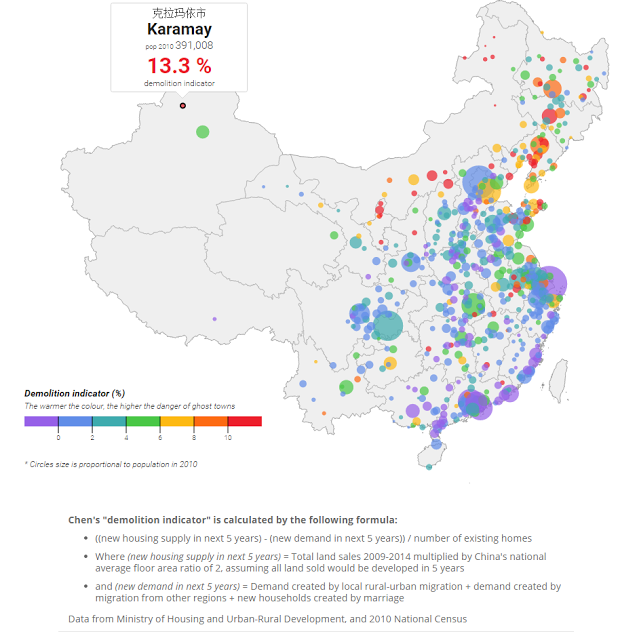The South China Morning Post has compiled a ghost town map based on an experimental model proposed by Chinese economic researcher Chen Qin, who considers two indicators: future supply and demand ratio; and measuring oversupply or undersupply against existing homes in one city.Though it has limitations, this could help shed some light on potential ghost towns, or where housing supply will substantially outstrip demand by 2020.From the map, the “ghost towns” are clustered in northeast China, where local economies rely heavily on natural resources, heavy industries and farming, and are not diversified enough to offer a variety of jobs.Ordos, the most well-known of China’s ghost towns, ranked first based on Chen’s second indicator – a result confirmed by the CLSA report, which predicted that the vacancy rate in Kangbashi (the new town in Ordos) would continue to deteriorate in the next five years.
“China Times” reporter recently visited when Xiangluowan business district to see there is still a lot of projects not yet completed, projects that have been completed are empty or have very high vacancy rates.
The latest news from the central business district of Binhai New Area Administrative Committee, as of the end of last year, there are 17 regional Xiangluowan building 13 projects completed this year there are eight buildings completed.
This means that, at the end of last year, only about one-third of project completion, the proportion of buildings completed only 35.4 percent. Even eight buildings be completed this year, the number of buildings completed in just over half also.
…Binhai New Area Central Business Zone official statistics, Sinosteel International Plaza building body mass of nearly 400,000 square meters, height of 358 meters, with a total investment of 4 billion yuan. The project was formally signed in April 2006 settled Xiangluowan scheduled for completion by the end of 2014, but delayed for eight years, currently only carried out earthwork excavation.
And Xiangluowan Moon Island project construction volume also more than 300,000 square meters, with a total investment of 1.8 billion yuan, is also just took earthwork excavation, but can not see the sign at the construction site.
These companies got a great deal on the land: almost free.
In addition, according to published reports, in order to attract investment, then the Binhai New Area will be used to support land transfer all projects or project support, which means that investment companies to buy land costs almost zero.
Nevertheless, the huge investment program has suffered setbacks in the implementation.
…With Sinosteel International Plaza project, for example, according to media reports, at the time of project planning Xiangluowan Tianjin Sino Steel Group Investment, China Steel International Ltd, the Diaoyutai State Guesthouse, the United States MGM MIRAGE joint development, but due to financial, steel high-level personnel changes and other reasons, the Diaoyutai State Guesthouse with the US MGM Group has pulled out of the project.
The rest of Tianjin is also adding a lot of office space:
The region’s developers said on condition of anonymity, Xiangluowan business district started 39 projects, most of which are local provincial and municipal governments or state-owned investment and development, and are the main high-end office, hotel or commercial complex, in fact, office space already is already in surplus.
According to DTZ report released in 2015, Tianjin Grade A office market will have a significant number of projects completed in order to enter the market, with the launch of new projects, the market vacancy rate is bound to rise.
Dingzu Yu, CEO of E-House China also believes that the commercial office products to be careful, he said the annual meeting planners in the Seventh China Real Estate “is currently building supply too much, especially in the new districts of second- and third-tier cities.”
宋清辉 told reporters that, in the long term, Tianjin Free Trade Zone Xiangluowan favorable business district, will bring its passenger and cargo traffic and popularity, but the limited short-term boost.
Those new districts are part of the urbanization and development plans in many cities. In many cases these are popular new areas of commerce, but in other cases, they are ghost cities. I covered it here last year: Urbanization Plans: 90% of Prefecture Level Cities in China Are Planning New Districts; Plans Would Increase Urban Area by 780%; Suitable for 3.4 Billion People.
Yesterday, the latest data “Securities Times” reporter from Shanghai E-House Real Estate Institute show that as of the end of January 2015, Shanghai E-House Real Estate Institute of monitoring of the total 35 cities in new commercial housing stock is 271.21 million square meters, mom fell 0.7 percent, an increase of 17.1% yoy.
Beijing mortgage rates have come down as well, with mortgage discounts climbing above 7%. Korean bank Woori is offering the largest discount of 15%. 北京首套房贷款平均利率走低 跌破9.3折
Chinese developers loosened their purse strings at the start of this year to replenish land banks in first-tier cities and a few second-tier ones on high expectations they will be the first areas to see a housing market recovery due to policy relaxation.
However, analysts warned that if reality fell short of expectations, interest would quickly cool, resulting in a similar pattern to the one seen last year. Possible catalysts for such disappointment mainly lurk on the policy side, including a serious effort to push ahead with property ownership registration next month.
A pilot scheme to blacklist developers who fail to pay land premiums in a timely manner or begin construction as scheduled, reportedly set to start this year in 11 cities including Chongqing and Nanjing, would also make developers rethink aggressive land bank building, analysts added.
Land sales in Beijing remain strong, Developers snap up Beijing plots:
Beijing’s land market is warming up again, with three mixed-use sites sold for 3.6 billion yuan on Tuesday, raising the total land sales to 40.9 billion yuan since January, according to mainland property data provider SouFun Holdings.


